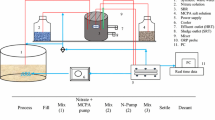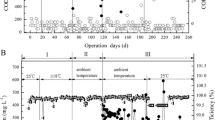Abstract
Chlorophenols (CPs) have drawn great attention due to their high toxicity and ubiquitous presence in the environment. However, the practical application of anaerobic biodegradation to remove CPs is limited by low degradation rate and incomplete mineralization. This work aims to apply a single-stage anaerobic fixed-bed bioreactor (AnFBR) for complete anaerobic dechlorination and mineralization of CPs. Results showed that 2-CP removal efficiency of 99.4%, chemical oxygen demand (COD) removal efficiency of 93.0%, and methane yield of 0.22 L-CH4/g-COD could be obtained for a wide range of 2-CP loading rates (3.6–18.2 mmol L−1 d−1). Nearly complete anaerobic mineralization of 2-CP was achieved even in the absence of co-substrates, thereby greatly reducing the operation cost. This may be partly related to the attached-growth microorganisms in AnFBR, allowing a higher biomass concentration and longer biomass retention time for enhanced 2-CP removal. Moreover, 16S rRNA gene sequence analysis suggests that the AnFBR harbored the potential dechlorinators (e.g., Anaeromyxobacter), phenol-degrading microbes (e.g., Comamonas and Syntrophobacter), and methanogens (e.g., Methanobacterium and Methanosaeta) after acclimation, which could cooperate effectively for 2-CP dechlorination and mineralization. Based on the identified intermediates, the possible mineralization pathway of 2-CP was proposed. These findings should be valuable to facilitate the engineering applications of AnFBRs for removing CPs from wastewater.
Similar content being viewed by others
References
Olaniran A O, Igbinosa E O. Chlorophenols and other related derivatives of environmental concern: Properties, distribution and microbial degradation processes. Chemosphere, 2011, 83: 1297–1306
Czaplicka M. Sources and transformations of chlorophenols in the natural environment. Sci Total Environ, 2004, 322: 21–39
Vlastos D, Antonopoulou M, Konstantinou I. Evaluation of toxicity and genotoxicity of 2-chlorophenol on bacteria, fish and human cells. Sci Total Environ, 2016, 551–552: 649–655
Bello D, Trasar-Cepeda C. Extraction and quantification of chlorophenolate molecules in soils spiked with 2,4-dichlorophenol and 2,4,5-trichlorophenol. Sci Total Environ, 2018, 616–617: 179–186
Peng S, Tang Z, Jiang W, et al. Mechanism and performance for adsorption of 2-chlorophenol onto zeolite with surfactant by one-step process from aqueous phase. Sci Total Environ, 2017, 581–582: 550–558
Yuan J, Wu Q, Zhang P, et al. Synthesis of indium borate and its application in photodegradation of 4-chlorophenol. Environ Sci Tech, 2012, 46: 2330–2336
Mu Y, Ai Z, Zhang L. Phosphate shifted oxygen reduction pathway on Fe@Fe2O3 core-shell nanowires for enhanced reactive oxygen species generation and aerobic 4-chlorophenol degradation. Environ Sci Tech, 2017, 51: 8101–8109
Li C X, Wang Y J, Chen C B, et al. Interactions between chlorophenols and peroxymonosulfate: pH dependency and reaction pathways. Sci Total Environ, 2019, 664: 133–139
Kojima Y, Fukuta T, Yamada T, et al. Catalytic wet oxidation of o-chlorophenol at mild temperatures under alkaline conditions. Water Res, 2005, 39: 29–36
Lin Q, Wang Z, Ma S, et al. Evaluation of dissipation mechanisms by Lolium perenne L, and Raphanus sativus for pentachlorophenol (PCP) in copper co-contaminated soil. Sci Total Environ, 2006, 368: 814–822
Martínez-Jardines M, Martínez-Hernández S, Texier A C, et al. 2-chlorophenol consumption by cometabolism in nitrifying SBR reactors. Chemosphere, 2018, 212: 41–49
Wang Y K, Pan X R, Sheng G P, et al. Development of an energy-saving anaerobic hybrid membrane bioreactors for 2-chlorophenol-contained wastewater treatment. Chemosphere, 2015, 140: 79–84
Zhao J, Chen X, Bao L, et al. Correlation between microbial diversity and toxicity of sludge treating synthetic wastewater containing 4-chlorophenol in sequencing batch reactors. Chemosphere, 2016, 153: 138–145
Moussavi G, Ghodrati S, Mohseni-Bandpei A. The biodegradation and cod removal of 2-chlorophenol in a granular anoxic baffled reactor. J Biotech, 2014, 184: 111–117
Cho S Y, Kwean O S, Yang J W, et al. Identification of the upstream 4-chlorophenol biodegradation pathway using a recombinant monooxygenase from Arthrobacter chlorophenolicus A6. Bioresource Tech, 2017, 245: 1800–1807
Kwean O S, Cho S Y, Yang J W, et al. 4-chlorophenol biodegradation facilitator composed of recombinant multi-biocatalysts immobilized onto montmorillonite. Bioresource Tech, 2018, 259: 268–275
Puyol D, Monsalvo V M, Sanchis S, et al. Comparison of bioaugmented EGSB and GAC-FBB reactors and their combination with aerobic SBR for the abatement of chlorophenols. Chem Eng J, 2015, 259: 277–285
Khan N, Khan M D, Ansari M Y, et al. Bio-electrodegradation of 2,4,6-trichlorophenol by mixed microbial culture in dual chambered microbial fuel cells. J Biosci Bioeng, 2019, 127: 353–359
Bajaj M, Gallert C, Winter J. Anaerobic biodegradation of high strength 2-chlorophenol-containing synthetic wastewater in a fixed bed reactor. Chemosphere, 2008, 73: 705–710
Chang C C, Tseng S K, Chang C C, et al. Reductive dechlorination of 2-chlorophenol in a hydrogenotrophic, gas-permeable, silicone membrane bioreactor. Bioresource Tech, 2003, 90: 323–328
Majumder P S, Gupta S K. Degradation of 4-chlorophenol in UASB reactor under methanogenic conditions. Bioresource Tech, 2008, 99: 4169–4177
Majumder P S, Gupta S K. Effect of carbon sources and shock loading on the removal of chlorophenols in sequential anaerobic-aerobic reactors. Bioresource Tech, 2008, 99: 2930–2937
Wang S G, Liu X W, Zhang H Y, et al. Aerobic granulation for 2,4-dichlorophenol biodegradation in a sequencing batch reactor. Chemosphere, 2007, 69: 769–775
Puyol D, Mohedano A F, Sanz J L, et al. Comparison of UASB and EGSB performance on the anaerobic biodegradation of 2,4-di-chlorophenol. Chemosphere, 2009, 76: 1192–1198
Majumder P S, Gupta S K. Removal of chlorophenols in sequential anaerobic-aerobic reactors. Bioresource Tech, 2007, 98: 118–129
Li Z, Inoue Y, Suzuki D, et al. Long-term anaerobic mineralization of pentachlorophenol in a continuous-flow system using only lactate as an external nutrient. Environ Sci Tech, 2013, 47: 1534–1541
Yousefzadeh S, Ahmadi E, Gholami M, et al. A comparative study of anaerobic fixed film baffled reactor and up-flow anaerobic fixed film fixed bed reactor for biological removal of diethyl phthalate from wastewater: A performance, kinetic, biogas, and metabolic pathway study. Biotech Biofuels, 2017, 10: 139
Geng Y K, Wang Y, Pan X R, et al. Electricity generation and in situ phosphate recovery from enhanced biological phosphorus removal sludge by electrodialysis membrane bioreactor. Bioresource Tech, 2018, 247: 471–476
Yuan L, Li Z H, Zhang M Q, et al. Mercury/silver resistance genes and their association with antibiotic resistance genes and microbial community in a municipal wastewater treatment plant. Sci Total Environ, 2019, 657: 1014–1022
Martínez-Gutiérrez E, Texier A C, de María Cuervo-López F, et al. Consumption of 2-chlorophenol using anaerobic sludge: Physiological and kinetic analysis. Appl Biochem Biotech, 2014, 174: 2171–2180
Sanford R A, Cole J R, Tiedje J M. Characterization and description of Anaeromyxobacter dehalogenans gen. nov., sp. nov., an aryl-halorespiring facultative anaerobic myxobacterium. Appl Environ Micro-Biol, 2002, 68: 893–900
Azwani F, Suzuki K, Honjyo M, et al. Draft genome sequence of comamonas testosteroni R2, consisting of aromatic compound degradation genes for phenol hydroxylase. Genome Announc, 2017, 5: e00875
de Bok F A M, Plugge C M, Stams A J M. Interspecies electron transfer in methanogenic propionate degrading consortia. Water Res, 2004, 38: 1368–1375
Smith K S, Ingram-Smith C. Methanosaeta, the forgotten methanogen? Trends MicroBiol, 2007, 15: 150–155
Graber J R, Breznak J A. Physiology and nutrition of treponema primitia, an H2/CO2-acetogenic spirochete from termite hindguts. Appl Environ MicroBiol, 2004, 70: 1307–1314
Chen X, Ottosen L D M, Kofoed M V W. How low can you go: Methane production of Methanobacterium congolense at low CO2 concentrations. Front Bioeng Biotech, 2019, 7
Martínez-Gutiérrez E, González-Márquez H, Martínez-Hernández S, et al. Effect of phenol and acetate addition on 2-chlorophenol consumption by a denitrifying sludge. Environ Tech, 2012, 33: 1375–1382
Rao N. Photocatalytic degradation of 2-chlorophenol: A study of kinetics, intermediates and biodegradability. J Hazard Mater, 2003, 101: 301–314
He Z, Wang C, Wang H, et al. Increasing the catalytic activities of iodine doped titanium dioxide by modifying with tin dioxide for the photodegradation of 2-chlorophenol under visible light irradiation. J Hazard Mater, 2011, 189: 595–602
Poulopoulos S G, Nikolaki M, Karampetsos D, et al. Photochemical treatment of 2-chlorophenol aqueous solutions using ultraviolet radiation, hydrogen peroxide and photo-Fenton reaction. J Hazard Mater, 2008, 153: 582–587
Tu Y, Xiong Y, Tian S, et al. Catalytic wet air oxidation of 2-chlorophenol over sewage sludge-derived carbon-based catalysts. J Hazard Mater, 2014, 276: 88–96
Chen D, Shen J, Jiang X, et al. Simultaneous debromination and mineralization of bromophenol in an up-flow electricity-stimulated anaerobic system. Water Res, 2019, 157: 8–18
Author information
Authors and Affiliations
Corresponding authors
Additional information
This work was supported by the National Key Research and Development Program of China (Grant No. 2016YFC0401101), the National Natural Science Foundation of China (Grant Nos. 51738012, 51708533, and 51821006), the Key Research Program of Frontier Sciences, CAS (Grant No. QYZDB-SSWQDC020), and the Fundamental Research Funds for the Central Universities (Grant No. WK2060190079).
Rights and permissions
About this article
Cite this article
Geng, Y., Li, Z., Yuan, L. et al. Degradation and mineralization of 2-chlorophenol in a single-stage anaerobic fixed-bed bioreactor. Sci. China Technol. Sci. 63, 86–95 (2020). https://doi.org/10.1007/s11431-019-9538-2
Received:
Accepted:
Published:
Issue Date:
DOI: https://doi.org/10.1007/s11431-019-9538-2




